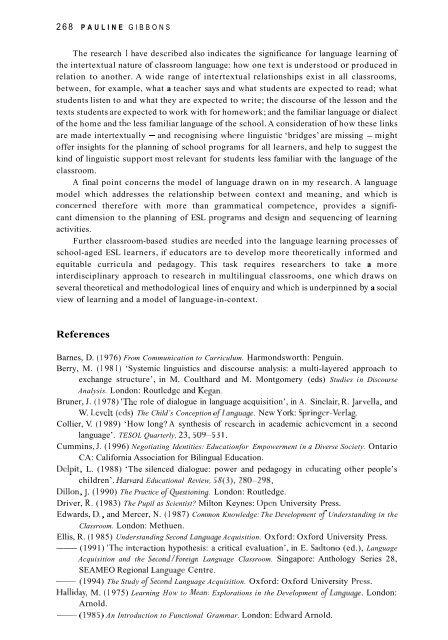English Language Teaching in its Social Context
English Language Teaching in its Social Context
English Language Teaching in its Social Context
Create successful ePaper yourself
Turn your PDF publications into a flip-book with our unique Google optimized e-Paper software.
~ (1991)~ (1994)~ (1985)268 PAULINE GIBBONSThe research I have described also <strong>in</strong>dicates the significance for language learn<strong>in</strong>g ofthe <strong>in</strong>tertextual nature of classroom language: how one text is understood or produced <strong>in</strong>relation to another. A wide range of <strong>in</strong>tertextual relationships exist <strong>in</strong> all classrooms,between, for example, what a teacher says and what students are expected to read; whatstudents listen to and what they are expected to write; the discourse of the lesson and thetexts students are expected to work with for homework; and the familiar language or dialectof the home and the less familiar language of the school. A consideration of how these l<strong>in</strong>ksare made <strong>in</strong>tertextually - and recognis<strong>in</strong>g where l<strong>in</strong>guistic ‘bridges’ are miss<strong>in</strong>g - mightoffer <strong>in</strong>sights for the plann<strong>in</strong>g of school programs for all learners, and help to suggest thek<strong>in</strong>d of l<strong>in</strong>guistic support most relevant for students less familiar with the language of theclassroom.A f<strong>in</strong>al po<strong>in</strong>t concerns the model of language drawn on <strong>in</strong> my research. A languagemodel which addresses the relationship between context and mean<strong>in</strong>g, and which isconcerned therefore with more than grammatical competence, provides a significantdimension to the plann<strong>in</strong>g of ESL program3 and dcsign and sequenc<strong>in</strong>g of learn<strong>in</strong>gactivities.Further classroom-based studies are needed <strong>in</strong>to the language learn<strong>in</strong>g processes ofschool-aged ESL learners, if educators are to develop more theoretically <strong>in</strong>formed andequitable curricula and pedagogy. This task requires researchers to take a more<strong>in</strong>terdiscipl<strong>in</strong>ary approach to research <strong>in</strong> multil<strong>in</strong>gual classrooms, one which draws onseveral theoretical and methodological l<strong>in</strong>es of enquiry and which is underp<strong>in</strong>ned by a socialview of learn<strong>in</strong>g and a model of language-<strong>in</strong>-context.ReferencesBarnes, D. (1976) From Communication to Curriculum. Harmondsworth: Pengu<strong>in</strong>.Berry, M. (198 1) ‘Systemic l<strong>in</strong>guistics and discourse analysis: a multi-layered approach toexchange structure’, <strong>in</strong> M. Coulthard and M. Montgomery (eds) Studies <strong>in</strong> DiscourseAnalysis. London: Routlcdgc and Kegan.Bruner, J. (1978) ‘The role of dialogue <strong>in</strong> language acquisition’, <strong>in</strong> A. S<strong>in</strong>clair, R. Jarvella, andW. Levclt (cds) The Child’s Conception oflanguage. New York: Spr<strong>in</strong>gcr-Verlag.Collier, V. (1989) ‘How long? A synthesis of rcscarch <strong>in</strong> academic achicvcmcnt <strong>in</strong> a secondlanguage’. TESOL Quarterly, 23, 509-531.Cumm<strong>in</strong>s, J. (1996) Negotiat<strong>in</strong>g Identities: Educationfor Empowerment <strong>in</strong> a Diverse Society. OntarioCA: California Association for Bil<strong>in</strong>gual Education.Dclpit, L. (1988) ‘The silenced dialogue: power and pedagogy <strong>in</strong> cducat<strong>in</strong>g other people’schildren’. Harvard Educational Review, 58(3), 280-298.Dillon, J. (1990) The Practice $Question<strong>in</strong>g. London: Routledge.Driver, R. (1983) The Pupil as Scientist? Milton Keynes: Open University Press.Edwards, D., and Mercer, N. (1987) Common Knowledge: The Development .f Understand<strong>in</strong>g <strong>in</strong> theClassroom. London: Methuen.Ellis, R. (1 985) Understand<strong>in</strong>g Second <strong>Language</strong> Acquisition. Oxford: Oxford University Press.‘The <strong>in</strong>tcraction hypothesis: a critical evaluation’, <strong>in</strong> E. Sadtono (ed.), <strong>Language</strong>Acquisition and the Second/Foreign <strong>Language</strong> Classroom. S<strong>in</strong>gapore: Anthology Series 28,SEAMEO Regional Languagc Centre.The Study $Second <strong>Language</strong> Acquisition. Oxford: Oxford University Prcss.Halliday, M. (1975) Learn<strong>in</strong>g How to Mean: Explorations <strong>in</strong> the Development ofLanguqe. London:Arnold.An Introduction to Functional Grammar. London: Edward Arnold.












